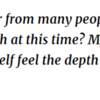Wilderness expert and renowned mindfulness teacher Mark Coleman shares how he is learning to hold the intense beauty of nature—and devastation of climate change—in his mindfulness practice.
Today, because of climate crisis and changing ecology, the sense of finding nature as source of nourishment is changing. We now live in an era where the impacts of global warming—unprecedented forest fires, species extinction, coral reef deaths—are impossible to ignore. Our very experience of nature is tinged, if not marred, by these looming realities.
Our grief and pain about such things is harder to push aside. The results of the climate crisis are mounting, becoming an enervating presence where once we drew pure pleasure and deep replenishment. Instead of relishing the majestic trees, abundant wildflowers, or breathtaking views, we confront drought conditions, flooding, or the smoky haze of distant forest fires. Our heart may feel heavy and weary or helpless at the scope of the problem.
The Australian eco-psychologist Glenn Albrecht coined a new term for this: solastalgia. It is a part of an emerging lexicon in the mental health field that endeavors to address the distress and anxiety that occurs in relation to the ecological crisis. Solastalgia, composed of two Greek words, solacium (comfort) and algia (pain), refers to the distress caused by environmental damage and speaks to the grief, sadness, and despair that arises in response to the current environmental devastation. Instead of joy there is a hopelessness, a knowing that what is loved is now under threat.
Of course, I am also aware this grief is not new. Indigenous cultures and First Nations peoples have felt it for centuries. They have and continue to witness ecological devastation of their homelands through land confiscation, drilling, mining, deforestation, and the monocrops of agribusiness. They perhaps are more vulnerable to the consequences of climate change, whether that be declining fish stocks, melting ice in the Arctic, or changing migration patterns. Our current tears are part of a river of tears that has been flowing for a long time.
To read more of Mark Coleman's article, please click here.



Comments (0)